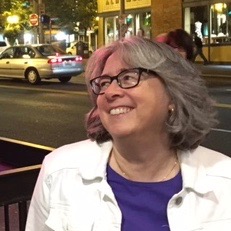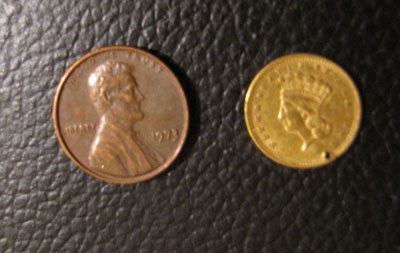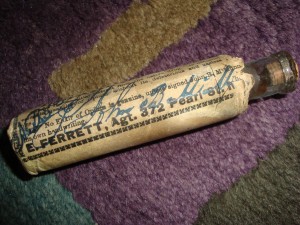My contributors copies of Crab Orchard Review arrived in the mail while I was away at Writers in the Heartland. When I got home, it was exciting to see my name on the back with at least one other I recognized (poet Erika Meitner). This story is excerpted from my novel, A USEFUL LIFE. Here’s hoping its publication will generate some interest in the novel.
Category: A Useful Life
“The Ninth of Av” forthcoming in Crab Orchard Review
I just found out that a story excerpted from my unpublished novel A Useful Life will appear in Crab Orchard Review‘s Special Issue: New & Old ~ Re-Visions of The American South. It’s scheduled to come out in September. The excerpt comes from the chapter about the 1878 yellow fever epidemic that decimated Memphis, telling the story of a fictional Jewish family and how they deal with the tragedy.
I titled the story “The Ninth of Av,” after the Jewish holiday commemorating the destruction of the temple in Jerusalem. In 1878, Tisha B’Av, as the day is called in Hebrew, occurred on August 8. At some point while revising that section of the book I realized that was about the same time of year as the yellow fever epidemic which nearly destroyed the entire city of Memphis. I saw that for my Jewish characters there were some parallels between the two events, so I juxtaposed their personal family tragedy temporally with this important date in Jewish history.
I’m thrilled to have a story coming out in such a respected journal. It’s a big milestone for me.
Artifact: Orton and Sadler’s Business Calculator and Accountants Assistant
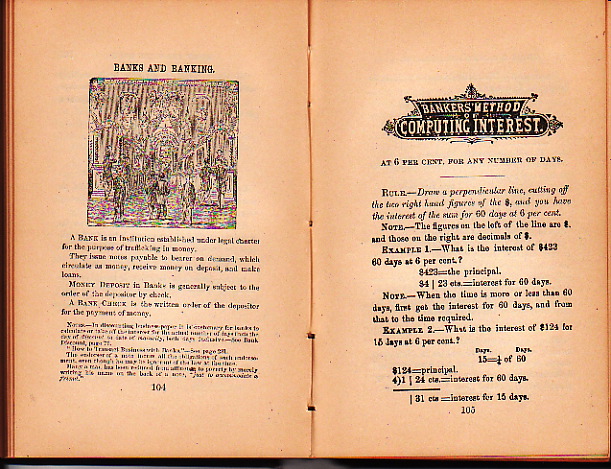
When I was researching my novel, I found it helpful to have artifacts that made me feel connected to the world my characters inhabited. Orton and Sadler’s Business Calculator and Accountants Assistant is one such artifact in my collection. It was published in Baltimore in 1877. One of the authors, W.H. Sadler, was the president of Bryant and Stratton Business College there. The title page proclaims it “A Cyclopaedia of the most concise and practical methods of business calculations, including many valuable labor-saving tables, together with improved interest tables, decimal system: showing the interest on from $10 to $10,000–rate, ten per cent. per annum.” In 1888, the price of the book was $1. I purchased it for $10 more than a hundred years later.
Two of my characters are bankers in the 1880s-1890s, so this book seemed like something they could have used. It’s a handy little compendium of everything from shortcuts for arithmetic computation to determining the weight of live cattle. Need to “Ascertain the cost of one quire of paper” in cents per pound? Page 264 has a handy table. How many cubic feet of stone constitute a perch? 24.75, of course. This was the interwebs in your pocket.
I thought I would have one of my characters refer to the book or use one of the tables, but I never found any natural way to work it in. I keep the book on my shelf, though. It’s one way I can touch the nineteenth century.
This idea might not be so strange. Jack Finney‘s characters used clothing and other artifacts to facilitate time travel through self-hypnosis in his book Time and Again and its sequel From Time to Time. I’m not a big science fiction fan, but that’s one of my favorite books. Perhaps there’s a bit of Finney seeping through my subconscious, giving me the idea of time travel through objects.
How about you other writers out there–do you collect objects to connect in a tangible way to your characters’ lives as you research?
Artifact: 1856 Gold Coin
I wanted the 19th century character in my novel to come into possession of a peddler’s pack with some money sewn into the bottom. I figured about $50 or so would be the right amount, so I put that into the story. Then I started to wonder how many coins that would be and what size they’d be.
On Ebay I found somebody selling an 1856 dollar gold coin–three years before my character encounters the pack. So far so good–until the coin arrived in the mail. As you can see by comparison with the penny in the photograph above, the coin is tiny and weighs next to nothing. It would take a lot of those coins to be noticeable in a canvas pack. I had to start rethinking the amount of money and how big the stack of coins would be.
Since a five dollar gold coin is a bit bigger, I decided to have ten of those sewn into the pack. I don’t have ten coins and a peddler’s pack to test, so I hope it’s at least plausible.
Artifacts: Opium Vial
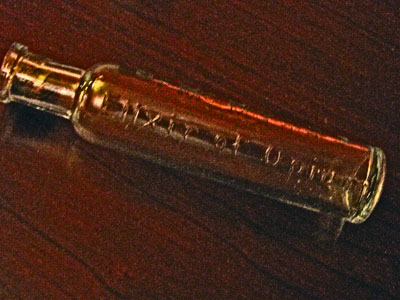 Opium plays an important part in the plot of my unpublished novel A Useful Life. Before I started writing, I researched the history of opium, its effects on the human body, and the behavior of addicts.
Opium plays an important part in the plot of my unpublished novel A Useful Life. Before I started writing, I researched the history of opium, its effects on the human body, and the behavior of addicts.
I was on a self-imposed writing retreat at a cabin in West Virginia when I wrote one of the scenes in which a character is experiencing hallucinations. It was summertime and extremely hot, so I was sitting outside on the bank of the river. At some point, I just couldn’t concentrate, so I went into town to browse the art galleries and antique stores.
Some of the booths in the antique stores were selling empty glass bottles and vials of various sorts, so I thought it might be interesting to search for something related to opium. When I saw the vial pictured above, I was elated. Embossed along the side are the words, “Dr. McMunn’s Elixir of Opium.” I had no idea if it was authentic, but it wasn’t too expensive, so I purchased it.
When I got home, I found on the internet that it was a popular brand of patent medicine available in the United States from about the 1840s until the 1900s. It was a product that could have been used by my character.
I’ve had the vial now for several years and keep it on the shelf in my writing studio. The thought of an upstanding citizen of a community being an opium addict was one of the ideas that sparked my imagination in the first place and made me want to write my novel. Why do some people succumb to addiction and how does it divert their life paths? What does it do to those around them? Is it possible to intervene? These are questions I wanted to explore. Of course, the novel asks many other questions as well, but the opium vial is a reminder to me of the genesis of this story.
 Here are a couple of other photos of a different vial with the wrapper intact. Thanks to Lynda Dalpe for sending these to me.
Here are a couple of other photos of a different vial with the wrapper intact. Thanks to Lynda Dalpe for sending these to me.
More About A USEFUL LIFE
My novel A Useful Life was a quarter finalist for the 2011 Amazon Breakthrough Novel Award. It’s about a woman researching her dead husband’s family in search of answers to questions he left behind.
I’ve been a genealogist for more than twenty years. I began researching my husband’s family because he thought his father had no relatives. I took that as a challenge. I now have more than three thousand people in his family tree going back to the 1600s. So much for no relatives.
Along the way we’ve met many third and fourth cousins around the world and become quite close to many of them. Those are the living ones, but in a way I feel quite close to some of the deceased ones too. As I dug up information about them, I found myself thinking about the lives and stories beyond the dates and facts. I read their letters and obituaries and felt I knew them somehow. When my research turned up something puzzling, I imagined logical explanations for their actions. I felt sad when I saw their death certificates and happy when I read their wedding announcements. I began to make up life stories for them in my head. Then I wanted to tell those stories, but I didn’t want the burden of footnotes and academic rigor, so I took those imagined lives and mixed them around and created fictional characters. They have some of the life facts of real people and they share a historical context with real people in the Jewish community of Memphis between 1859 and 1893, but their personalities, their actions, their behavior, are made up.
This is all to say that the 19th century characters in my novel are not my husband’s ancestors, nor are they really based on his ancestors. They’re people I imagined lives for, based on what I learned about what it was like to live in Memphis in 1870 or 1880. The main character researching her dead husband’s family is not me, my husband is not dead, and her sons are not my sons. I created her and her genealogical journey to explore history, the meaning of family, and the surprising things we discover about ourselves when we embark on that journey.
Quarter-Finalist in the Amazon Breakthrough Novel Award Competition
Back in January, I entered my first unpublished novel, A Useful Life, in the Amazon Breakthrough Novel Award (ABNA) competition, along with about 5,000 other fiction writers (there is a separate competition for Young Adult manuscripts). I didn’t have high hopes for advancing to the next step because the judging was only on the 300-word pitch, but I did make the cut to 1,000. A few days ago I learned that I made the quarter-finals cut to 250. This was unexpected.
I have queried some agents with this novel. I had revised it and was about to start sending it out again when I entered the contest. I do have some ambivalence about the contest route versus the traditional agent-seeking route, which I’ll blog about at some later date. In the meantime, reviewers from Publishers Weekly are reading the entire manuscript and will decide whether it goes on to the semi-finalist round.
Update: 4/26/11
My novel did not make it to the semi-final round. I did get very positive reviews from the Amazon reviewers and the Publisher’s Weekly Reviewer. In the meantime, I’ve been rearranging and editing again, and I think it’s stronger now. I’ll begin querying agents once again soon. Thanks to everyone who reviewed my excerpt while it was posted on the Amazon website.
I am now older than my main character
When I first started writing my novel, I made my main character several years older than I was. There were several reasons:
- People I know might be less likely to confuse my main character with me, the real person
- The main character would have grown up with a different set of ideas about how women should live their lives, which was useful in giving her the husband I gave her
- Her kids would be considerably older than my real kids and less likely to be confused in people’s minds with my own kids (see #1)
All that is now out the window. Technically she is still older than I am, because her birth date is before mine, but she is frozen in the present-day of the novel. I am, apparently, not. To my horror, I am now older than she is in the present-day of the novel and my children are rapidly approaching the ages of her children. It’s going to be more difficult to convince people this is not my life and my family if (when) my novel is published. Unless it takes another twenty years, in which case, no worries.
